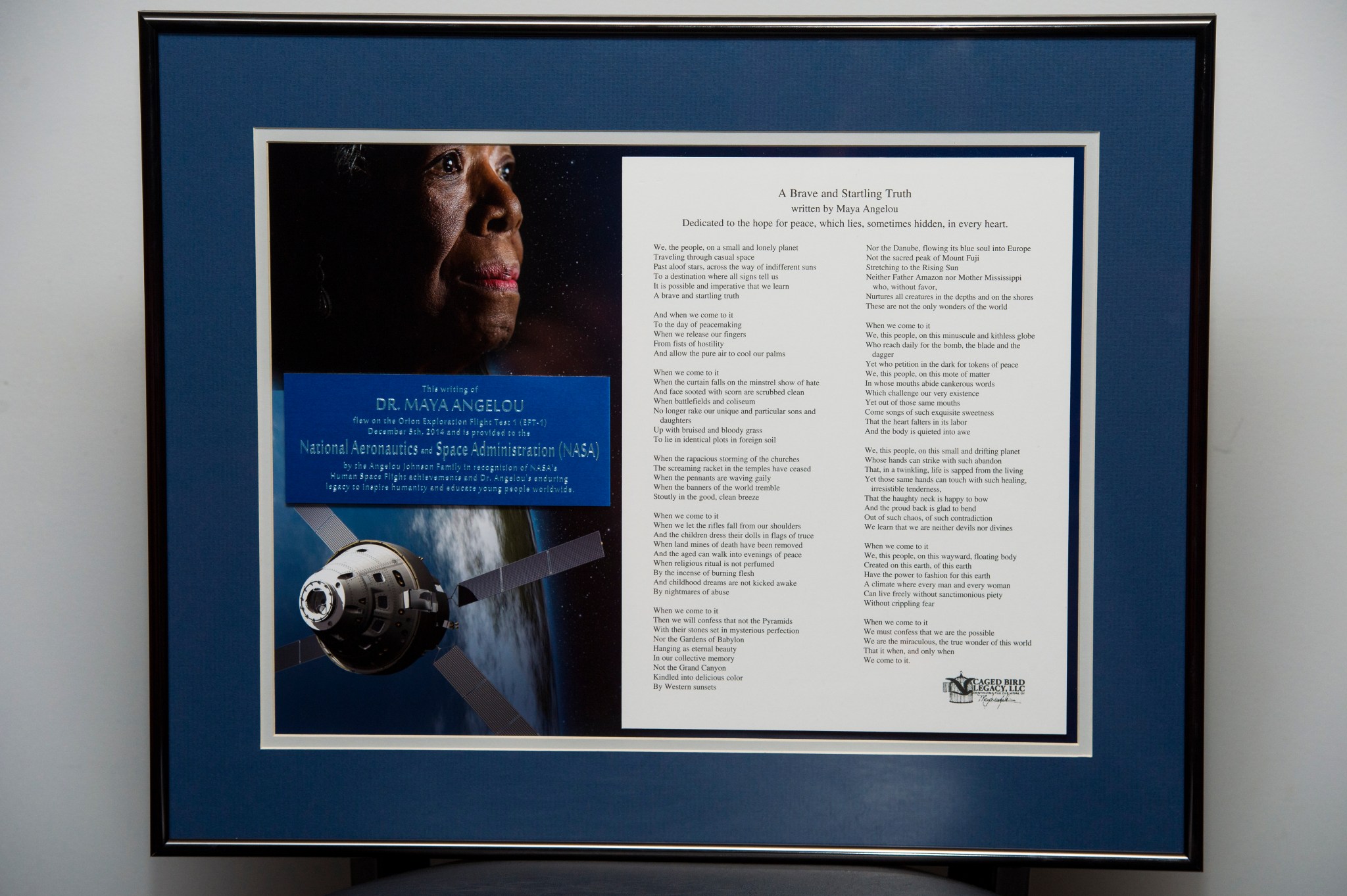
During the first flight test of NASA’s Orion, the spacecraft flew more than 3,600 miles into space to test many of the systems critical to safety before it begins carrying astronauts to new destinations in the solar system, including to an asteroid and on toward Mars. While the flight tested thousands of hardware and software elements, Orion also carried with it several mementos and commemorative items to mark the spacecraft’s march toward enabling human deep space exploration, including poetry written by American poet Dr. Maya Angelou.

Text of Angelou’s poem, A Brave and Startling Truth flown on Orion during its December 2014 voyage into space was presented April 6 to NASA Administrator Charles Bolden during a ceremony at the agency’s Headquarters in Washington.
“It is fitting that Maya Angelou’s prophetic words be flown not only outside the bounds of our Earth, but on the maiden voyage of a spacecraft that represents humanity’s aspirations to move beyond our planet, to reach higher, and become more than we have ever been,” said Bolden. “Through art, and the unique perspective of people like Maya Angelou, our discoveries, and the new facts and expanded understanding brought to us by exploration, are transformed into meaning.”
Angelou was a renowned and influential American voice. She was a celebrated poet, memoirist, educator and civil rights activist, and passed away a few months before Orion’s flight test.
During the ceremony at NASA Headquarters, Bolden was joined by Angelou’s son, Guy B. Johnson, and grandsons Elliott Jones and Colin A. Johnson.
“We are honored to continue the legacy of Dr. Maya Angelou with her literary items flown on Orion,” said Colin A. Johnson. “They truly embody my grandmother’s quote, ‘I stand alone and go forth as thousand’ as they represent all on us on this planet as they push the edges of what we think is achievable.”
Lockheed Martin, NASA’s prime contractor for Orion, composed the manifest for the flight test in collaboration with NASA. The company’s vice president and program manager for Orion, Mike Hawes, also attended the ceremony.
“So much of Dr. Angelou’s work speaks to human ambition and dreams,” said Hawes. “It was an honor to take some of her work with us on Orion’s first flight—a moment in history signifying the pursuit of dreams for many years to come.”
Orion’s successful flight was an uncrewed two orbit, 4.5 hour test that compiled many of the riskiest events Orion and its future crews will experience during their missions. After flying 3,600 miles in altitude, Orion reentered the atmosphere at speeds of 20000 mph and temperatures of about 4,000 degrees Fahrenheit before splashing down in the Pacific Ocean. Other items were flown on Orion in several stowage lockers placed in the spacecraft before its flight, including an assortment of flags, coins, patches, pins, educational items and a variety artistic works. Other excerpts of Angelou’s writings were also flown, including When Great Trees Fall, Our Grandmothers, On the Pulse of Morning, Phenomenal Woman, And Still I Rise, Caged Bird, Weekend Glory and the book I Shall Not Be Moved.
Engineers around the country already are hard at work preparing the next Orion spacecraft for its journey farther into space. During Exploration Mission-1, an uncrewed Orion will fly atop NASA’s Space Launch System rocket to a distant retrograde orbit around the moon, where the agency will relocate a boulder from an asteroid for exploration by astronauts in the 2020s. Other commemorative items to inspire future generations and mark the deep space journey may fly on Orion during the mission.


























